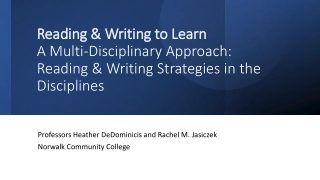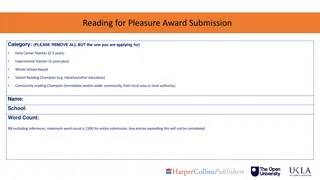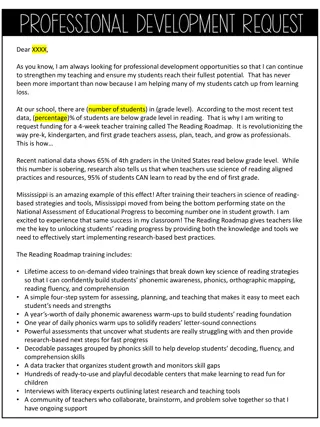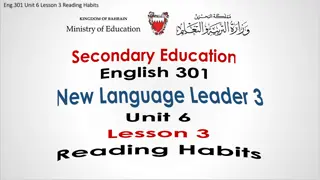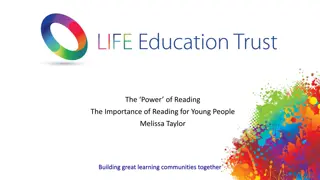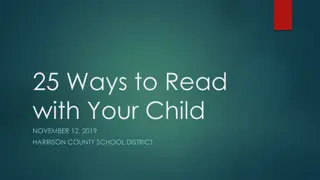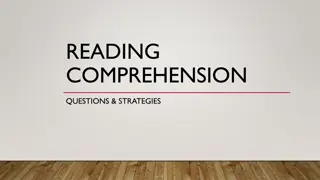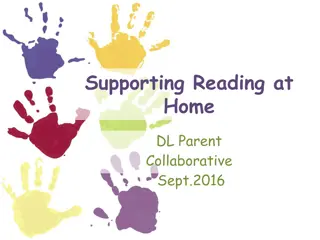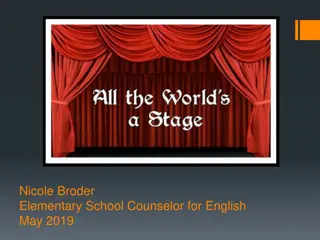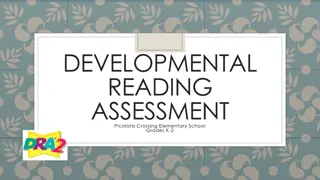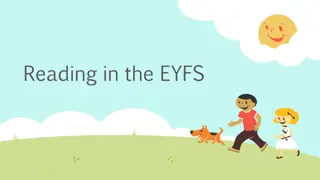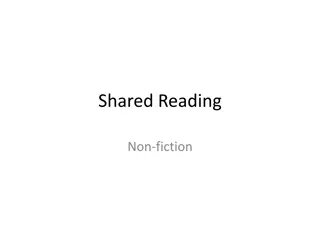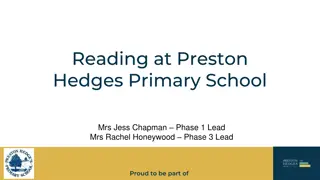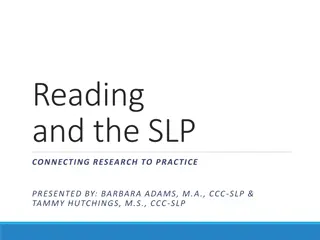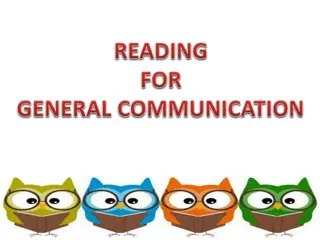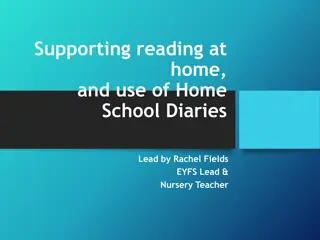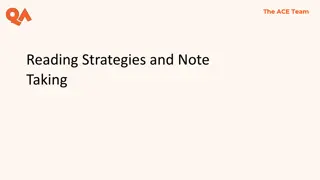Exploring Reading Strategies for Primary Students
This resource delves into various reading strategies used in class, such as Prior Knowledge, Metalinguistics, Visualisation, Inference, and Main Ideas/Summarising. The Prior Knowledge strategy involves analyzing the cover, characters, setting, and genre before reading. Metalinguistics focuses on the author's writing style, word choices, and language use. Examples and explanations of each strategy are provided to enhance primary students' reading comprehension skills.
Download Presentation

Please find below an Image/Link to download the presentation.
The content on the website is provided AS IS for your information and personal use only. It may not be sold, licensed, or shared on other websites without obtaining consent from the author. Download presentation by click this link. If you encounter any issues during the download, it is possible that the publisher has removed the file from their server.
E N D
Presentation Transcript
Thinking Reader Strategies Primary 5 2019-2020 This resource goes over reading strategies we use in class.
The Strategies Prior Knowledge Metalinguistics Visualisation Inference Main Ideas/Summarising
Prior Knowledge This is a before reading strategy although it can be used throughout a text when a new character, setting or word is introduced. Explore what you know about a text by: Looking at the front cover and any images. What do they images tell you about characters, setting, plot, genre? Who is the author/illustrator? Do you know any other books they have worked on? Who are the main characters? What can you tell about them? Age, gender, characteristics What genre of book is it? How do you know? Who do you think the book is aimed at? Why? Do the colours used tell you anything? Have they used light, bright and happy colours? etc.
Prior Knowledge All the characters look happy and cheerful, which makes me think there will be a happy ending. Fergus looks like he is celebrating. The author is Sir Chris Hoy who is a World & Olympic champion cyclist. The story could be set anywhere in the world. I think this because there are lots of different flags in the background such as Australia, Germany and China. The dog is holding a Scottish flag. The series is Flying Fergus . I think Fergus is the main character. I think the author uses the word Flying to show he s fast and has chosen the name Fergus because it s a Scottish name. The title of this book is Photo Finish . A photo finish in sports is when two or more competitors cross the finish line very close together. This tells me that the race Fergus is in must be very close. This looks like a fictional story that children in primary school would like. I think people who are interested in cycling or sports would enjoy it.
Metalinguistics This is a big, fancy word for language! We can explore the language the author uses in different ways: Do they have a certain style of writing? Are they funny, do they include lots of interesting details, do they leave you guessing? Do they choose certain words to convey a meaning? Do they use language/words you need to look up the meaning of? Can you think of synonyms for words they use? Do they use rhyme? Do they use alliteration e.g. Alice awoke alone in the dark, deathly silent room (repeating the starting letter or sound). Do they change the font they use? E.g. He shouted, STOP, but they couldn t hear him.
Metalinguistics The word you is written in italics (slanted font). I think the author has done this to put emphasis on the word. The word queer means strange or peculiar. Here the author uses adjectives to help paint a picture in the readers mind of what a Witch looks like. I think the author wants to build suspense by having the grandmother answer in short sentences and doesn t want to give away too much information just yet. The use of adjectives and a simile helps the reader visualise grandmother her old wrinkled lips shut tight as a pair of tongs .
Visualisation Authors help you build up an image in your head of the characters, setting and plot. Creating a visual image (in our head or on paper) can help us make connections, understand the text better and remember different parts of the story. What helps us visualise? Adjectives! Describing the look, feel, taste, smell and sound of things. Similes are comparisons using as or like He was as fast as a racing car. Her eyes were as blue as a sapphire. The trees towered over us like mountains and made us feel as small as mice.
Visualisation Can you draw an image of the Green Giant? How easy/difficult was it? Why do you think this?
Inference To infer something means you re reading between the lines and using clues given by the author/illustrator to help you do this. With inference, it s your opinion! So there isn t always one correct answer as it s your interpretation. This is a during reading strategy. What helps us infer information? Using prior knowledge can help us make links in the text. Reading the descriptions of the characters facial expressions, their body language and the way they speak. Are they slumping over and huffing? This might tell you they are fed up. Looking a picture clues (if they are available). What does the characters face or body language tell you? Making predictions about what is happening and what might happen next. Answer using phrases such as I think , From the clues I can tell , I know that
What is the relationship between Paul and Alice? I think Paul and Alice are a couple or Alice could be his mum. I think Alice looks after and cleans the house, and that s why she would be cross if Paul came in in his work clothes. Alice also seems to boss Paul about. What does Paul do as a job? He wears muddy boots so he must work outside. He also have dusty overalls. I think the dust could be residue from the equipment he works with. I think Paul is a builder or mechanic. Inference Every day after work Paul took his muddy boots off on the steps of the front porch. Alice would have a fit if the boots made it so far as the welcome mat. He then took off his dusty overalls and threw them into a plastic garbage bag; Alice left a new garbage bag tied to the porch railing for him every morning. On his way in the house, he dropped the garbage bag off at the washing machine and went straight up the stairs to the shower as he was instructed. He would eat dinner with her after he was presentable, as Alice had often said. What are the differences between the two characters? It seems like Alice is the one telling Paul to be neat and tidy. I think if Alice wasn t there to do that then Paul wouldn t think twice about walking through the house in his messy work gear.
Main Ideas/Summarising These are after reading strategy. Identifying the main ideas and writing a summary: By being able to identify the main ideas and producing a summary you are showing you have understood the text. It is important to pick out main ideas, such as characters and setting, but not spoil the plot for someone who hasn t read the story! You should aim to write you summary in your own words rather than copying directly from the text. Creating a list or bullet points can help you summarise the text.
Main Ideas/Summarising Can you work out which book this is a summary of? I ve omitted words to make it a little trickier! The third book in the ___________ series, ________________, focuses on the main character confronting an infamous prisoner. He has escaped from a well- known prison known as _________, and has made his way to __________ school. The main characters much prepare himself in the Defence Against the Dark Arts in order to combat his new foe!


